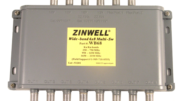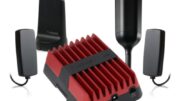Folks, this is just a drive-by article. If you want a really in-depth discussion of how to upgrade your DIRECTV system, check out the most-downloaded satellite tutorial on the internet.
OK nice and easy here, for real. You’re installing a satellite TV system for a commercial building. You need to feed a total of 50 receivers. Naturally you’ve opted for two SWM-30 multiswitches because it makes wiring easy. You’re also using the Legacy Reverse Band 5 dish because you want to be futureproof. You’re running seven lines down from the roof, which gives you some comfort knowing that even if one line breaks, you’re good.
Now here’s the hard part. You’re going to use six of these Skywalker splitters (pictured above.) This is absolutely the most critical part of the operation.
Each line from the splitter must go into the same port of each SWM.
Here’s what I mean by that.
You’re going to run a line from the dish into the splitter. (If you’re really serious you’re also using an amplifier and polarity locker.) One output goes into the 18V port on one SWM. It’s critical that the other output goes into the 18V port on the other SWM. And so forth, until all six lines are connected.
Make sure to completely test all the outputs on the SWMs before cleaning up your installation. It’s really best to ignore the urge to clean everything up before it’s tested. With 12 connections to make, it’s very easy to lose track of which is which and connect things to the wrong port. If you do that, something won’t work right.
How can you tell if you have it right?
If you have everything hooked up right, then an AIM meter hooked up to any port is going to pass EIV. (You are using an AIM meter, right? It’s the best choice for installation professionals.) It will be very easy to check.
What happens if you have it wrong?
Generally what will happen is that you’ll have one failure on one SWM and a different, almost parallel failure on the other. This happens because the signal coming down the line is only ever going to be one of six different types. (There are six different types of signals, which is why you need six different cables.)
If you have one splitter hooked up wrong, then you’ll have two of them hooked up wrong. So what you’ll see is on one SWM, you’ll get (for example) 101 odd transponders but not 101 evens. On the other one you’ll get 101 evens and not 101 odds. Or you’ll get 101 odds but not 103 evens on one, 103 evens but not 101 odds on the other. For the most part the two SWMs will have problems that are different from each other and usually seem the opposite.
At that point the first thing to do is disconnect everything from one SWM and reboot the other (by unplugging and replugging it.) If the one SWM which is connected starts working perfectly, you’ve found the problem.
Now all you have to do is disconnect everything, trace every cable and do it all over again.





